20 July – 6 Aug 2013. Where to begin? I said something similar to that in the last post. The Guelaguetza Festival is so huge and so spectacular that I hope I can convey some of the sheer joy, happiness and excitement we experienced at this event – the best of life, the best of human endeavor, the best of community.
While we were staying in La Manzanilla, and expressed to people that we would travel a little around Mexico before returning to Vancouver mid August, we heard several times go to Oaxaca, go to Oaxaca. When I was told that the state of Oaxaca has the highest population of indigenous people in Mexico it became an immediate draw for me. Sixteen separate indigenous cultures are recognized. Then I kept getting this thought look up festivals in Mexico and then I’d forget. Then it would come again look up festivals in Mexico and then I’d forget. And again look up festivals in Mexico. Finally I did it and discovered Guelaguetza would be held at exactly the time we were planning to go to Oaxaca. Miraculous serendipity!
From the moment we arrived we were consumed by Guelaguetza. The word Guelaguetza is Zapotec meaning offering or gift. The celebration pre-dates the arrival of the Spanish, and was originally a celebration of the ancient deities, especially the corn goddess Centeotl. It was also an integral part of the ancient cultures at weddings and baptisms, and later, after the integration of the Catholic faith, at the celebration of the village patron saint day. Everyone in the community would bring gifts of food, and drinks and whatever was needed so the celebration could happen. All contributed, all brought offerings: Guelaguetza.
The festival today is a huge affair popular with foreign tourists, and even more so with Mexican tourists who come from all over the country. The indigenous people of Oaxaca present their traditional dances, music, costumes and food. It’s a wild party where their cultural traditions are affirmed, deepened, shown to each other and the world, and madly celebrated. It’s about maintaining their traditions, sharing their traditions, and gifting. After every dance performance gifts are thrown to the crowd, ranging from tiny woven corn-sheaf artifacts, to traditional pastries, to small plastic bottles of mescal, to pineapples. Yes pineapples. Beware the flying pineapples!
There was so much going on. We didn’t want to be overwhelmed, or try to do so much we’d be exhausted. We decided to focus on the dance. Every day there were dance performances, most were free, some were in a theatre, some outdoors, and there were four major performances at the sold-out 10,000-seat stadium on the hill. We were lucky enough to get tickets in the front section to one of the performances at the stadium.
This site has some wonderful detailed information about some of the dances. A direct quote: Traditional dances mean more than a few hours of amusement to people from the Oaxacan coast. They are an important social event and moreover are attributed with profoundly magical and religious meaning. A dancer does not take part for his or the public’s entertainment, but as a prayer to the powers above, to seek their approval, to show them devotion and respect.
Instead of presenting this chronologically, or by venue, I’ve decided to group it according to the dances since we saw some performers more than once in different locations, and, sadly, some not at all.
Every group had its own band, frequently, though not always, a brass band. I’ve never seen so many tubas.
Many of the villages hold their own celebrations and we decided to go to one to get a more intimate experience of Guelaguetza. We chose the town of Santa Maria del Tule. Apart from the festival, Tule is known for its tree, the Arbol del Tule. It’s a two-thousand-year-old Montezuma cypress. The biggest tree I’ve ever seen, and home to thousands of small birds that flitted in and out of its many crevices. We sat by it and took it in, or tried to – its size, its life, its enormous and ancient presence: a tree for the ages!
A woman is standing on the left, giving an idea of its size.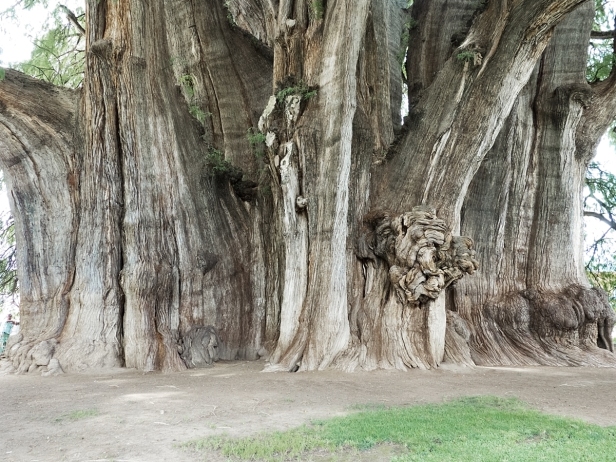

The Tule celebrations were held in the town stadium that I suspect was once used for bull fighting. There were dancers from several different regions and ethnicities of Oaxaca.
This construction is covered in fireworks and held high over the head as the fireworks explode. We saw some at the stadium too. Spectacular!
The audience
I was unable to establish the town or ethnicity of the following two groups of dancers but we loved their exuberant performances.

This next was one of the most spectacular and intriguing dances. It’s an Afro-Mexican dance from Costa Chica on the Oaxacan coast. In the site linked above there is a quite detailed description of its history and meaning. The Devil’s Dance was originally a ritual performed by African slaves in a plea to the god Ruja to be freed from slavery. The head devil carries a whip, perhaps symbolic of the whips used against the slaves on the plantations, and he whips the devils into action. The female devil is known as La Minga, and tries to disrupt the other devils using seduction. We knew none of this at the time – we simply experienced it as this outrageous exciting puzzling mind-boggling extravaganza that suddenly appeared in front of us.
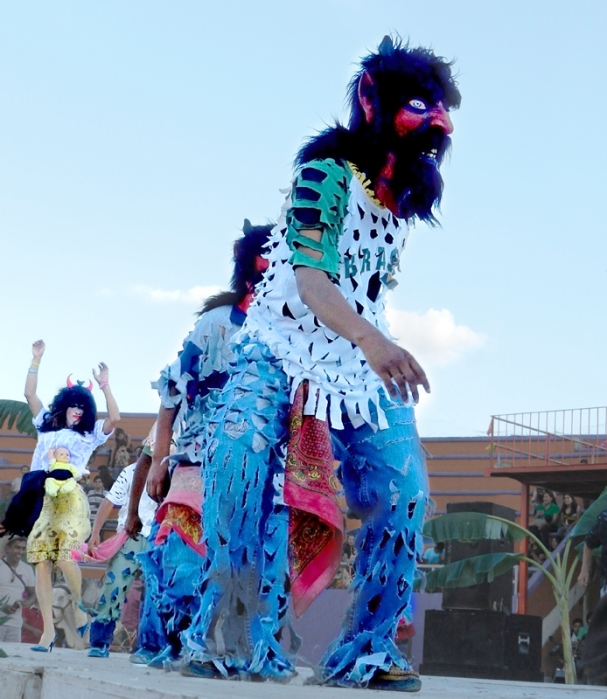
The Parade! On both Saturdays of the festival almost all the different groups of dancers participated in a Calenda des Delegaciones, or Parade of Delegations, through the streets of Oaxaca. We arrived early at the starting point to get photos of the groups as they arrived. Before we knew it, as we were photographing the later arrivals, up front and around the corner from us the parade had begun, so we walked with the parade. I was trying to get to the front but it never happened as people lining the streets that I wanted to photograph kept distracting me. The dancers didn’t walk: they danced! Non-stop for about an hour and a half or more, each with their own band playing. It was a riotous crowded joyous melee. Every now and then someone would yell out Viva Oaxaca! and the crowd would respond Viva Oaxaca!, and then Viva Guelaguetza! and the crowd would respond Viva Guelaguetza!, and Viva Mexico! It was so much fun. The streets were packed on either side. And on either side was a stream of people, including me and Don, moving with the parade. And squished in the middle the musicians playing to beat the band, and the dancers dancing their big hearts out.
A few shots from the audience. Many people dressed for the occasion.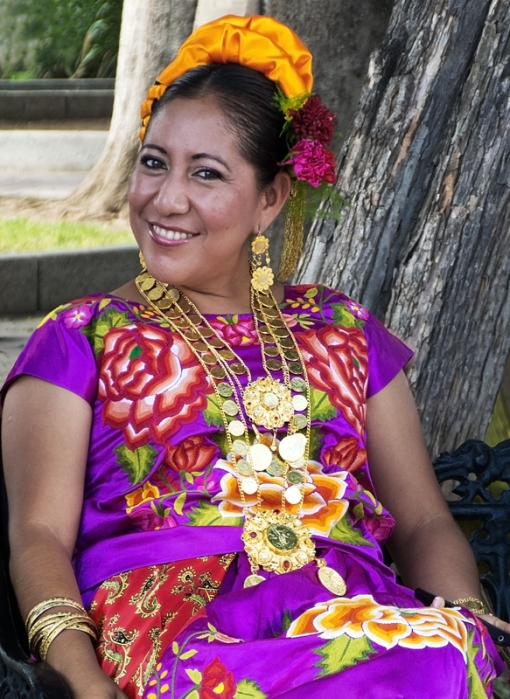
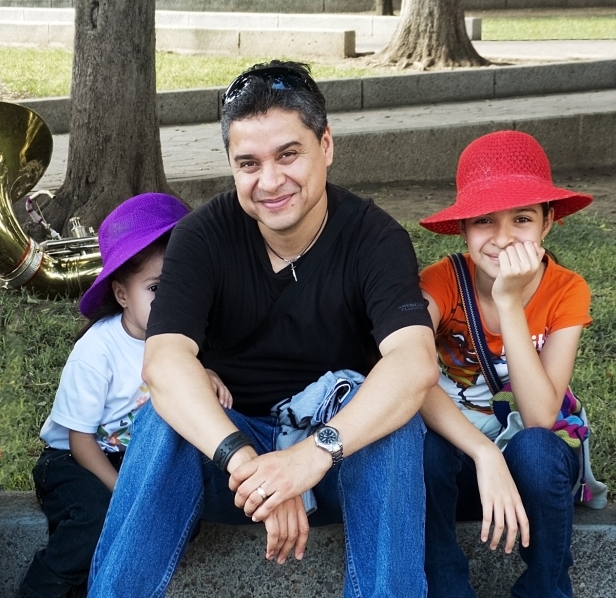




Waiting for it all to begin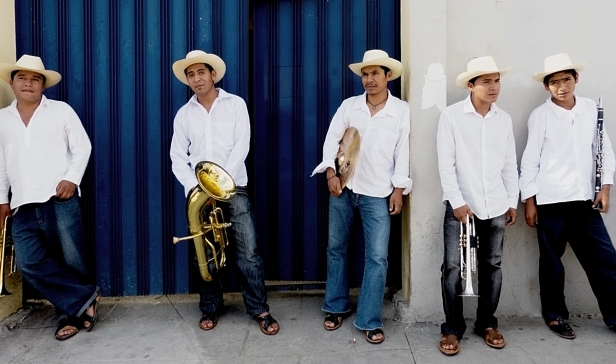
The performers from Villa Hidalgo Yalalag in the Sierra Juarez region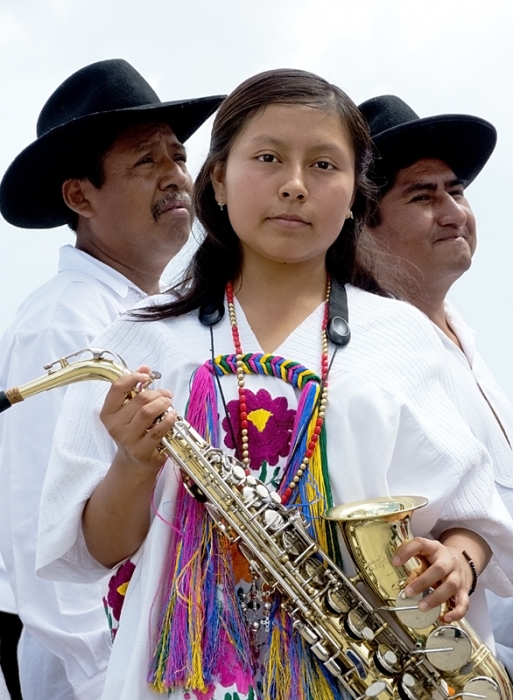


The dancers from San Juan Colorado before the parade. Almost all the groups we saw had at least one child dancing alongside the adults. This little boy kept up like a pro in a dance that included sword play. He was matched with the big guy with the horse.

performing the Danza de los Chareos at the stadium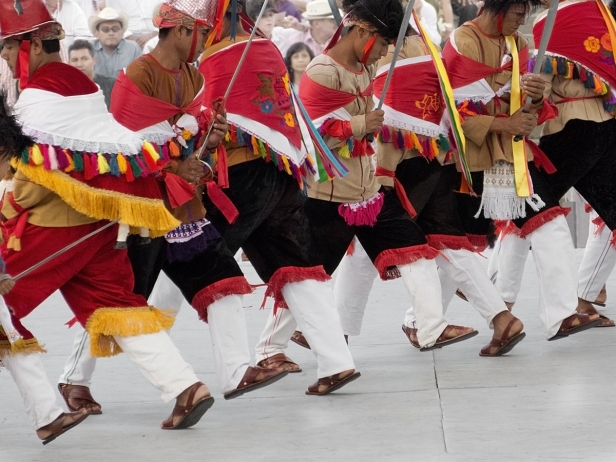
and after the parade was over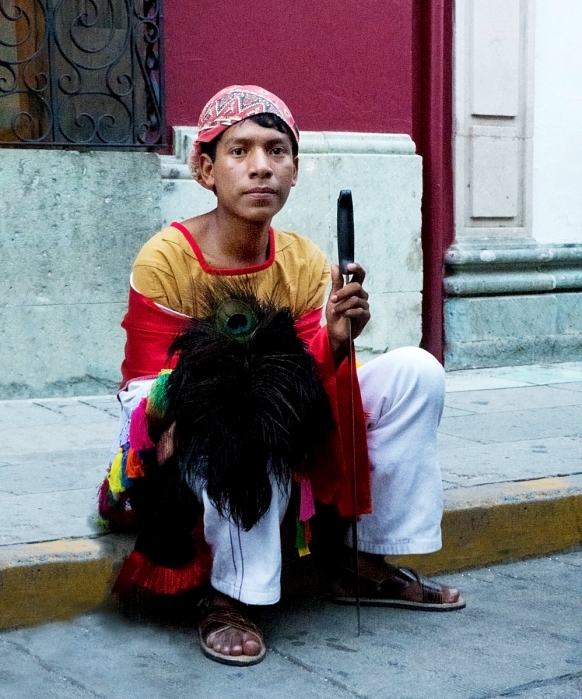
Three towns in Oaxaca are known for their brightly painted woodcarvings of fantastical creatures known as alebrijes. Of course there was a giant one in the parade, and you can see the woman in the left of this picture holding a small one. Also in this photo, and the next, are the Conquistadores that are a part of the Danza de la Pluma, which I’ll show in a future post.

These women are from the San Antonio Huitepec Delegation from Zaachila
From San Antonio Castillo Velasco comes the guajolote, or turkey dance. Yes he really is holding a live turkey with cigarettes and greenery and garlic dangling from it, and one of the women dances holding it high above her head. Unfortunately we didn’t get to see that.

I couldn’t find any information about this group
or this tiny boy who was one of several dressed in these giant hats.
At the end of the parade
And at the end of the parade we collapsed into a nearby restaurant for much needed sustenance. In the next post – a theatre performance of mime and dance from the people of the Istmo who have the most beautiful costumes of all, and the Oaxacan State Folkloric Ballet performance of Centeotl, the Corn Goddess.
All words and images by Alison Louise Armstrong unless otherwise noted.
© Alison Louise Armstrong and Adventures in Wonderland – a pilgrimage of the heart, 2010-2015.

I keep wondering how you Alison and your husband have the courage to do all this travelling, in awe ( I am in AWE ).
Every working day, I sit in front of my computer ( I am 59 years old already, and working as a Civil Engineer ), and I keep saying to myself……another few more months ( eh, 24 months also another few more months what ! ), before I retire for good……another few more months.
Jeeeez, I hope that me and my wife will have the courage to travel, as you 2 have.
God bless.
Bye.
From: H
LikeLike
Hello H, nice to meet you, and thanks for commenting. One day you will just realise that you really are done with work. And then you will retire.
Between now and then read blogs like ours, and read about the places you’d like to go, and research the ways to get there and where to stay and what to see. The more information you have the less vulnerable you feel. Perhaps start with a tour for your first trip. If you go on a tour you have everything taken care of and all you have to do is show up. It opens the doors to other countries in a cushioned way so there’s little stress. Research the tour company before you book it. Tripadvisor is great for user reviews of just about everything related to travel. You’ll have a great time once you just dip your toe in!
Blessings
Alison
LikeLike
These portraits you took are incredible. Well done!
LikeLike
Thank you very very much (and praise the Lord for zoom lenses). I think one of my faves is the Danza Los Chareos dancer against the orange wall.
LikeLike
I know you got a new camera recently. What did you get, and are you happy with it? Loved these pics!
LikeLike
I’m still looking, and haven’t decided yet. I have a bridge camera – a Panasonic FZ150 with 24x optical zoom which is light and compact. I’m wanting to upgrade to a full DSLR but weight is an issue – I plan on looking into what’s new in the coming couple of weeks.
LikeLike
The photos really capture so much. They feel alive, full of energy. Really great post. 🙂
LikeLike
Thanks Paulette. There was so much aliveness! Everyone was excited and full of joy. I’m glad I managed to capture something of how it was.
LikeLike
Wonderful as usual! Bravo~
LikeLike
Thanks Cindy.
LikeLike
WOW ! I don’t know where to begin myself, to comment…just amazing.
The tree! I really want to be by that tree…I didn’t even see the woman at first!
xx
LikeLike
It was an amazing festival – so blown away that we lucked into it.
Isn’t that tree just incredible?! I’ve never seen anything like it. It was hard to take in how old and how big it is.
LikeLike
Awestruck! Would love to see it..
LikeLike
What an amazing trip you guys had – the colour, the people, the hairstyles! 🙂 Where are you off to next? Somewhere just as exciting? Enjoy your time in Canada ~ Lakshmi x
LikeLike
Hi Lakshmi. Oh, yes, it was amazing. So much colour and joy. Next we’re off to Montreal to visit with my sister and her family for 3 weeks, and then South and Central America for 6 months.
xox
LikeLike
Wow…how exciting. You enjoy seeing your family and I will look forward to following you on your next trip 🙂 Safe travels ~ Lakshmi x
LikeLike
Beautiful. I feel like I’m right there with you in these photographs!
LikeLike
Thank you so much Felicity. Happy to have you along 🙂
LikeLike
Lovely photographs …. specially of the audience … 🙂
Love the devil in the dance too…. 🙂
LikeLike
Thanks Rajni. Glad you enjoyed the photos. It was an extraordinary festival – so much to photograph! And, yes, that devil dance was quite astonishing 🙂
LikeLike
This festival looks amazing, I’m really stunned by the quality of your photos as usual. What camera are you using?
LikeLike
Thanks Danny. I have a bridge camera. It’s a Panasonic FZ150 with a Leica lens and a 24x optical zoom. I’m thinking of upgrading to a full DSLR if I can find one that’s not too heavy.
Unashamedly Photoshop is my friend 🙂
LikeLike
Really cool! 🙂 Thank you! ❤
LikeLike
Thanks 🙂
Glad you liked it ❤
LikeLike
Had to smile about the photoshop Alison. It and I spend a lot of time together. (grin) That tree is something else. As you probably know from my blogs, I like big trees! Great shots of the festival and the color. The dresses twirling really caught my attention. And the people are quite handsome. Peggy and I just returned from Burning Man (another great festival) and will actually be home for awhile ourselves. –Curt
LikeLike
Thanks Curt. Isn’t that tree amazing?! *You* may be home for a while 🙂
We are on the move again tomorrow – 3 weeks in Montreal with family then 6 months in South America.
Bet you had a fabulous time at Burning Man – looking forward to reading more about it.
Alison
LikeLike
Love the dance photos. But I am in awe of that tree. Must have been quite an experience standing next to the tree of life.
Wouldn’t want to get hit by a flying pineapple, but would love to see that Devil dance. Thanks for letting us experience the “gift” of these dances to honor the Divine. {{{hugs}} Kozo
LikeLike
Thanks Kozo. Isn’t that tree awe inspiring?! The sheer size and energy of it is extraordinary. And the devil dance was certainly something else. All the dances are sacred in their own way and the dancers take their job very seriously. It was amazing to be a part of it.
(((((hugs)))))
Alison
LikeLike
Alison, Oaxaca is truly a magical place – you captured it’s essence so beautifully. And it looks like you were there at the perfect time. What a festival! I was captivated by the incredible dance photos. Great post! All the best, Terri
LikeLike
Thanks Terri. We really lucked into being there for Gulaguetza. It was an amazing time – more posts to come. Ten days of dance performances!
Cheers
Alison
LikeLike
Hi Alison & Don…I JUST found your website after following your comment over from Kelly at TRY NEW THINGS…..I guess you could say I was trying something new…and started reading about your trip to Oaxaca. I have actually been talking to my husband about a trip there and you’ve made me so-o-o want to go. We actually planned a trip there about 5 years ago but they were having a mini-revolution of sorts so we delayed the trip…but the trip we had planned was for the fall and now I think we need to make it during the Guelaguetza Festival. Your photos are fabulous and I so appreciate your enthusiasm in describing everything. I’m looking forward to all of your posts about Oaxaca and many more to come. ~Kathy
LikeLike
Hi Kathy, nice to meet you. I’ve been travelling around your blog for a while – great energy. Your joy for life shines through. I love the SMART idea.
Would highly recommend going to Oaxaca for Guelaguetza. We also stayed a week beyond it and did some out of town trips. I have about 4 more posts on our Oaxaca experience still to come so you’ll get more of an idea.
Thanks for visiting our blog and for following. I hope you enjoy the stories of our journey, both inner and outer.
Blessings
Alison
LikeLike
Hi Alison….thank YOU for the warm welcome….and I am so looking forward to your next posts (especially about Mexico) And after they’re done I’ll probably pick your brain with a few questions about our potential trip… 🙂 ~kg
LikeLike
Wow! i kept looking for the person by the tree and finally located her…amazing! this is a wonderful collection and must have been time consuming organizing all of it to post. great work! the mask of La Minga dancers – scary!
i enjoyed this. thanks. ☺
LikeLike
Thanks Sunshine. Yes I must admit I was initially a bit overwhelmed as to how to post about Guelaguetza but finally got it down to bite-size bits. Two more posts to come. So glad you enjoyed it. Isn’t that tree amazing?!
LikeLike
it is an amazing tree!!
LikeLike
Alison & Don very well documented pictures could not believe the size of the tree we went to Lumbini Nepal lately Buddha birth place that tree could not compare with the size.
LikeLike
Hello you two. Isn’t the Tule tree astonishing?! I’d certainly never seen anything like it. Hope you had a good time in Nepal. We hope to get there one day.
LikeLike
Hi Alison, I have loved reading your posts about the Guelaguetza, thank you so much for sharing. We are going to Oaxaca this summer and will be there are the start of the festival (arriving July 17 and leaving v late on the 21, which is the first of the two Mondays.) My boyfriend is reluctant to go to the official show (a bit long and pricey) but I would love to see some smaller shows around town – will there be lots on or is going to the big show the best thing to do? Hope to hear from you, Francesca
LikeLike
There will be so much on you’ll hardly be able to take a breath. Apart from the dance performances there’s a food festival, a mushroom festival, and a mescal festival – all happening in town. Plus free dances every day at at least one location, and probably 2 (I can’t quite remember). The smaller location had dancing every day – we got there early to get a good position for photographing (about 4ish) and the dancing started at 5, or if it was raining after the rain stopped. The bigger location (Plaza de la Danzas) I think had free performances every day but I’m not sure. And then there’s the parade on the Saturday where you’ll get to see a whole lot. It’s not the same as the performances as space is restricted on the streets but you’ll still get to see a lot of dancing and to join in the party. I kind of recommend going to the beginning of the parade where all the dancers meet before it begins to get the best view of their costumes and they do a little impromptu dancing while waiting to begin. The streets are PACKED during the parade so you might not see much. Parade begins at Jardin Conzatti – I’m fairly sure this is right. The best thing to do is when you first arrive go to the tourist office (on Juarez at Humbolt) and get a map and a program and ask about all the locations. Specifically ask for the location of the daily free dance performances and the start of the parade. And they’ll tell you about all the other things going on as well.
After having said all that I still recommend doing all that AND getting tickets to the stadium. Splurge! For the best seats! It’s so worth it. It’s not too long – the atmosphere is electric. Well it was for me anyway, but then I love ethnic dancing. I imagine you can’t go to the afternoon performance which I think is better (because of the fireworks) but doesn’t finish until about 10pm or even later. Hope all this helps. Have a fabulous time! Alison
LikeLike
Wow, thank you so much for your reply – we really appreciate your advice and are now looking forward to our trip even more! Hope you are having a great time wherever you are, F
LikeLike
You’re welcome. We’re back in Vancouver for a few months – it’s nice to be in familiar surroundings and to reconnect with friends and family. A
LikeLike